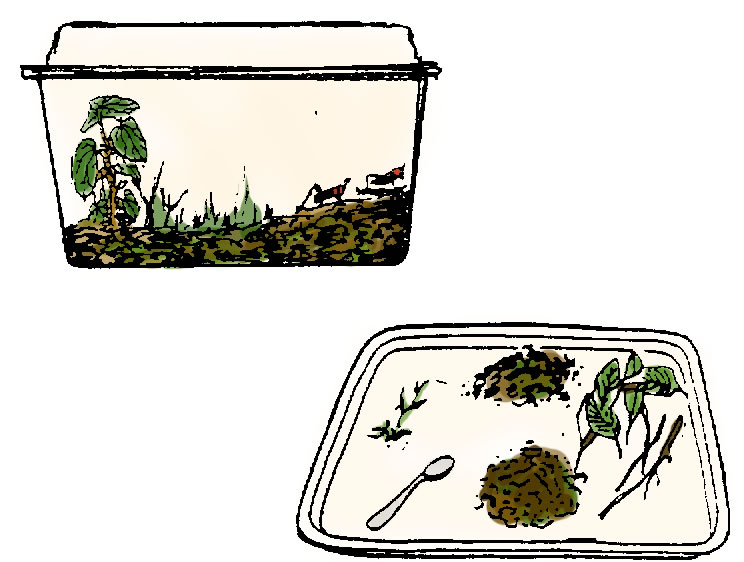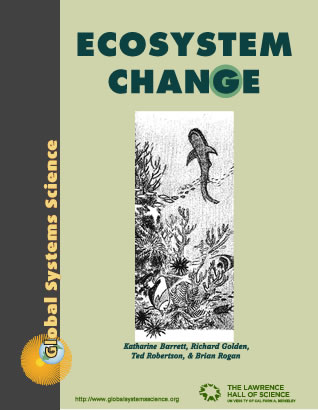EC1.1. Make A Model Ecosystem
Design your own miniature ecosystem in a clear plastic or glass container and observe it for at least one month.
In the following laboratory investigation, you will design a small model ecosystem in a terrarium and follow the changes in the living and non-living components of the system. Some of the questions you will need to consider include the following: What will the organisms consume? What will they produce? What substances may be reused in your system? What cycles may occur over time?

What You Need:
- 1 large clear container with lid
- 1 large spoon for adding materials
- light source such as a grow lamp
- non-living materials
- small plants and animals
- measuring equipment: scales, measuring cup, ruler, thermometer, graph paper, camera (optional)
Choose Some Items from Each Category:

| Inorganic Materials | Organic Materials | Living Organisms |
|---|---|---|
| sand; pebbles; rocks | garden soil* (not potting soil) | plants (alyssum, strawberry, violet) |
| natural clay | dead leaves (maple, birch, elm, etc.) | seeds (bird seed, grass seed, beans) |
| water; iron nail | bark and twigs; bone, egg shell | carrot top; earthworms; crickets |
| corncob | pill bugs, sow bugs; wolf spider, beetles |
* Soil is a mixture of inorganic, organic, and living things.
Avoid using commercial potting soil, which may contain chemicals harmful to the insects.
Getting Started
Begin by developing a plan for investigating a relationship that you find interesting. The example on the next page outlines an experiment with temperature. You may want to work with a partner and plan several model systems.
Temperatures and Terrariums
Setup an experiment in a terrarium to test the effects of increased temperature on the model system.
What You Need
- 1 terrarium with at least 3 different kinds of plants
- 1 heating pad with variable control
- 3 thermometers
- an outline for conducting your experiment over a period of several weeks
- a chart or daily log for recording your observations
Experimenting with a Temperature Gradient
- Choose a location for your terrarium that does not get direct sunlight.
- Measure and record the starting temperature of the terrarium.
- Place a heating pad under 1/3 of the terrarium and set the control knob so that the temperature increases by 5° Celsius at one end of the terrarium. [See Temperature Scales.]
- Check the temperature above the heating pad to make certain it remains close to the desired 5 °C increase.
- Keep a record of any changes you see in the terrarium. Record vegetation change on a weekly basis. Note which species decrease in number and which species increase in each half of the terrarium.
- Sketch your experiment.
Discuss Your Results
- What changes did you observe in the growth and distribution of organisms?
- What changes did you observe in the physical characteristics of the terrarium environment?
- Describe any surprises or particularly interesting developments.
- How would you improve your experiment?
- What do you predict will happen if you continue your experiment through a complete life cycle of one of your plant species?
- Decide on a format to use for reporting your project, for example:
Title: Observing a Model Ecosystem
Idea or Hypothesis:
Materials & Organisms:
Methods: Describe how you will regulate and monitor factors such as light, air flow, temperature, and moisture levels.
Predictions: What changes do you think you will see? Consider possible food chains and life cycles.
Sketch the model: Show organisms, non-living components, input and outflow of energy. Graph paper is useful for mapping objects.
Daily Log: Keep a record of changes as well as things you add or remove.
Select a place to keep the ecosystem where you can observe it for a month or more.
Gather your materials and set aside about one hour for building the system.
Record the mass of materials, length and numbers of organisms you add.
Questions to Consider
- How many things are consumed or produced within your model system?
- Does your model ecosystem operate as a living organism? Explain.


